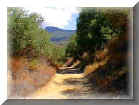The Bird Houses & Feeders
Bird feeders are the most popular and
well-known form of what I call "Feed Stations". They're easy and they
provide almost instant gratification. Bird feeders can be approached
from many angles. You can throw some bread crumbs out the back door or
you can buy designer seed tailored to each species of bird. I'm new at this
and I'm learning as I go along.
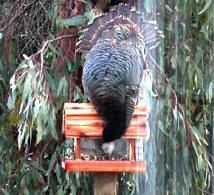 We started with a
simple hummingbird feeder and now we're evolving to the more elaborate
feeders. This is a photograph of a wild turkey visiting my first feeder and
its taught me a few things. For one, birds prefer to eat off the
ground. They will always clean up the seed I throw on the ground
before they move to the feeder. Leaving seed on the ground has the advantage
of providing room for more and different varieties of birds. Without an
outdoor cat, I've felt safe in encouraging the birds in this way though I'm
gradually weaning the birds to use the safer feeders.
We started with a
simple hummingbird feeder and now we're evolving to the more elaborate
feeders. This is a photograph of a wild turkey visiting my first feeder and
its taught me a few things. For one, birds prefer to eat off the
ground. They will always clean up the seed I throw on the ground
before they move to the feeder. Leaving seed on the ground has the advantage
of providing room for more and different varieties of birds. Without an
outdoor cat, I've felt safe in encouraging the birds in this way though I'm
gradually weaning the birds to use the safer feeders.
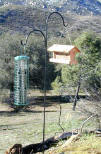 It helps to have
more than one feeder. They get crowded and without room, the birds
jostle and bully the milder birds. I've also had a problem with ground
squirrels raiding the feeder and carting away days worth of seed in a matter
of hours. I'm trying hanging the feeders rather than mounting them on poles
and I've just ordered a
Squirrel
Proof Feeder that shuts off from the weight of the squirrel.
More about our bird houses & feeders...
It helps to have
more than one feeder. They get crowded and without room, the birds
jostle and bully the milder birds. I've also had a problem with ground
squirrels raiding the feeder and carting away days worth of seed in a matter
of hours. I'm trying hanging the feeders rather than mounting them on poles
and I've just ordered a
Squirrel
Proof Feeder that shuts off from the weight of the squirrel.
More about our bird houses & feeders...
The Deer Feeder
Since the fire of 03' we've seen no deer in
our area. The paucity of undergrowth, poor food sources and dogs on
neighboring properties have all contributed to this. On the positive
side, we have King Creek that flows through the property and provides a
"fair" wildlife corridor from the upper elevations on Cuyamaca Peak. I say
"fair" because the deer will still have to run the gauntlet of developed
areas along the creek. (I'm not criticizing my neighbors as I include our
place in that description).
When I worked for the State of California
as an Irrigation Specialist they would occasionally send me to landscape
seminars in other parts of the country. I found it interesting that in those
areas, deer are considered a pest and people had to take extraordinary
measures to deter them.
My plan is to provide a deer feeding
station in one of the more isolated spots along King Creek.
More about our deer feeding station here.
You
can also e-mail me and I will put you on an update list about my efforts.
The Water Holes
 We live in drought
country with blistering hot summers and months without rain. Water
isn't just important, it's imperative for encouraging wildlife to visit.
You don't have to build elaborate ponds with squirting fountains and ceramic
frogs to encourage wildlife. We're not building a theme park, we're
looking for end results. A simple dish pan sunk into the earth will
work.
We live in drought
country with blistering hot summers and months without rain. Water
isn't just important, it's imperative for encouraging wildlife to visit.
You don't have to build elaborate ponds with squirting fountains and ceramic
frogs to encourage wildlife. We're not building a theme park, we're
looking for end results. A simple dish pan sunk into the earth will
work.
This is a photo of one of our small
watering holes. It's just an old sink basin that Catherine buried and
surrounded with rocks. She has it fed with a hose that slowly drips
water causing a slight overflow which encourages the surrounding foliage.
It's stocked with a couple of feeder fish from Wal-Mart who survive on
mosquitoes and other bugs. This tiny pond has croaking frogs and gets
visits from raccoons, coyotes, bob-cats and hundreds of birds.
Some basics:
The Dead Trees
- Also called snags or "Wildlife Trees"
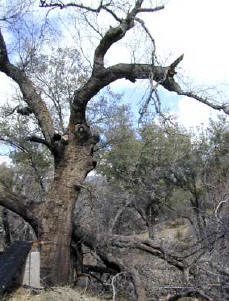 Our property is
dotted with trees that died from the drought or were burned in the 2003
firestorm.
Naturalist have started using the term "Wildlife Tree" to describe dead
trees that provide a natural wildlife habitat. If you look close, you
can see that dead trees and brush provide homes for all sorts of flora and
fauna. The branches provide convenient perches, bugs help decompose
the bark and provide food for birds and the holes provide nesting places for
Woodpeckers, Flickers and Titmice.
Our property is
dotted with trees that died from the drought or were burned in the 2003
firestorm.
Naturalist have started using the term "Wildlife Tree" to describe dead
trees that provide a natural wildlife habitat. If you look close, you
can see that dead trees and brush provide homes for all sorts of flora and
fauna. The branches provide convenient perches, bugs help decompose
the bark and provide food for birds and the holes provide nesting places for
Woodpeckers, Flickers and Titmice.
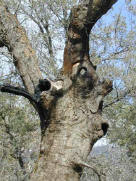 Your obsessively
neat neighbors might snicker about all this and some may become downright
argumentative. There's just something about country people and their
chainsaws. I really think it's some sort of macho hang-up but they'll use
every excuse in the book so they can fire up the old buzz saw. Often they'll
evoke the safety argument and claim that they're just trying to protect "the
children". Many times the forest service will use the same rationales
though when you dig a little deeper, you'll find that lucrative tree service
contracts have more to do with it than safety.
Your obsessively
neat neighbors might snicker about all this and some may become downright
argumentative. There's just something about country people and their
chainsaws. I really think it's some sort of macho hang-up but they'll use
every excuse in the book so they can fire up the old buzz saw. Often they'll
evoke the safety argument and claim that they're just trying to protect "the
children". Many times the forest service will use the same rationales
though when you dig a little deeper, you'll find that lucrative tree service
contracts have more to do with it than safety.
Please pardon my cynicism. I've been
reading too much Edward Abbey .
.
